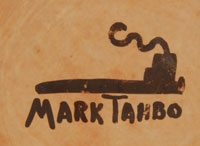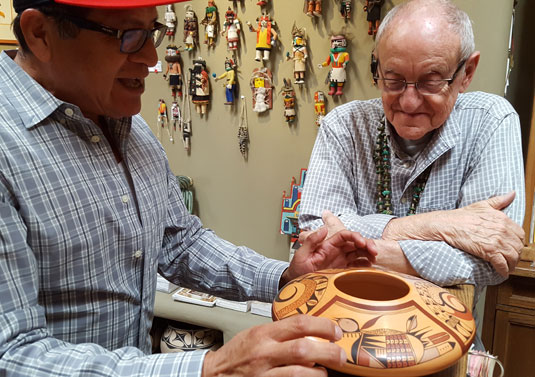Magnificent Hopi Pueblo Pictorial Seed Jar [SOLD]
+ Add to my watchlist Forward to Friend
- Category: Modern
- Origin: Hopi Pueblo, Hopituh Shi-nu-mu
- Medium: clay, pigments
- Size: 3-5/8” height x 10” diameter
- Item # C4096A SOLD
When Mark Tahbo brought us this jar on August 16, 2016, he surprised us with two innovations that were new in his artistic endeavors, but we will get to those a little later. Initially one needs only to take a look at the shape of this seed jar and admire the amazing pictorial designs on the upper portion. There are four design panels and each is different.
To start from the beginning, that is, the construction of the vessel, we listened to Mark explain where and why he chose the clay for this jar. Mark has always admired Garnet Pavatea and her production of pottery so he decided to visit the clay source Garnet used and to gather enough of that clay to make this jar. That clay bed is on the side of the road from the village of Polacca to the top of the mesa where Garnet lived.
After building the vessel with the “Garnet” clay, as he said, he set it aside until he could decide what decorations to use. He then fell back to the inspirations from Nampeyo of Hano and her use of Sikyatki designs. The panel of design with a sweeping red curve, that represents a stylized Sikyatki bird, has multi-colored polka dots on the body. Mark said he thought the earlier potters would have used dots placed on with the end of a stick rather than stippling as seen on later Hopi pottery. Arched over this bird is a band of rain clouds and rain.
 On the opposite side of the jar is another Sikyatki bird. This one has a black beak and stippling on the body. A band hovering over this bird has a different style of clouds and rain.
On the opposite side of the jar is another Sikyatki bird. This one has a black beak and stippling on the body. A band hovering over this bird has a different style of clouds and rain.
The other two panels of design feature realistic bird forms, and, of course, each is different. Mark said that the birds he sees at Hopi are small and fat so he made these birds fat. One of them is almost exclusively rendered in black pigment with a couple red feathers. The other bird is multi-colored. A portion of it is painted with black pigment and some of the feathers on the body are in red. The innovation or experimentation on this jar is the color he used on this bird that he called mauve. The bird’s head, tail feathers and a spot on the body were painted with the mauve pigment.
Generally, Hopi potters paint a wide framing line near the neck and another one at the shoulder which serve as a frame for the design. Mark decided to present a single framing line that rides over the birds and under the two stylized birds. His thinking on this is it would leave the design more open rather than framed. He also chose to make this framing line red rather than black. He used the pigment he made from a rock, a pigment he has used in the past with much success.
It is quite appropriate to say that Mark Tahbo created another masterpiece. It is also appropriate to say that I am not surprised.
Condition: original condition
Provenance: from our clients who purchased this on August 21, 2016 while Mark Tahbo was in the gallery and charmed them with his enthusiasm for his creation. They have returned it to us due to family financial situations.
Recommended Reading: Hopi-Tewa Pottery: 500 Artist Biographies by Gregory and Angie Schaaf

- Category: Modern
- Origin: Hopi Pueblo, Hopituh Shi-nu-mu
- Medium: clay, pigments
- Size: 3-5/8” height x 10” diameter
- Item # C4096A SOLD



